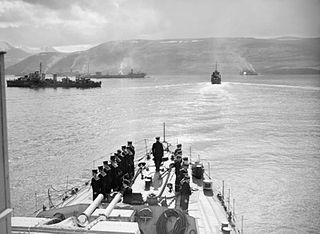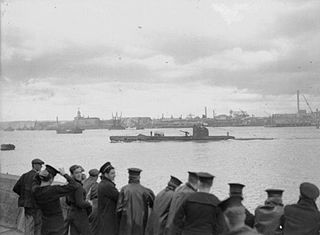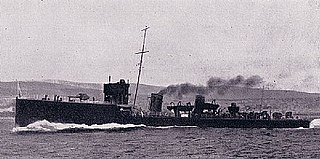
A cruiser is a type of warship. Modern cruisers are generally the largest ships in a fleet after aircraft carriers and amphibious assault ships, and can usually perform several operational roles from search-and-destroy to ocean escort to sea denial.

The Battle of Heligoland Bight was the first Anglo-German naval battle of the First World War, fought on 28 August 1914, between ships of the United Kingdom and Germany. The battle took place in the south-eastern North Sea, when the British attacked German patrols off the north-west German coast. The German High Seas Fleet was in harbour on the north German coast while the British Grand Fleet was out in the northern North Sea. Both sides engaged in long-distance sorties with cruisers and battlecruisers, with close reconnaissance of the area of sea near the German coast—the Heligoland Bight—by destroyer.

PQ 17 was the code name for an Allied Arctic convoy during the Second World War. On 27 June 1942, the ships sailed from Hvalfjörður, Iceland, for the port of Arkhangelsk in the Soviet Union. The convoy was located by German forces on 1 July, after which it was shadowed continuously and attacked. The First Sea Lord Admiral Dudley Pound, acting on information that German ships, including the German battleship Tirpitz, were moving to intercept, ordered the covering force based on the Allied battleships HMS Duke of York and USS Washington away from the convoy and told the convoy to scatter. Because of vacillation by Oberkommando der Wehrmacht, the Tirpitz raid never materialised. The convoy was the first large joint Anglo-American naval operation under British command; in Churchill's view this encouraged a more careful approach to fleet movements.

Admiral of the Fleet John Cronyn Tovey, 1st Baron Tovey,, sometimes known as Jack Tovey, was a Royal Navy officer. During the First World War he commanded the destroyer HMS Onslow at the Battle of Jutland and then commanded the destroyer Ursa at the Second Battle of Heligoland Bight. During the Second World War he initially served as Second-in-Command of the Mediterranean Fleet in which role he commanded the Mediterranean Fleet's Light Forces. He then served as Commander-in-Chief of the Home Fleet and was responsible for orchestrating the pursuit and destruction of the Bismarck. After that he became Commander-in-Chief, The Nore with responsibility for controlling the east coast convoys and organising minesweeping operations.

HMS Unbroken (P42) was a Royal Navy U-class submarine built by Vickers-Armstrong at Barrow-in-Furness; it was part of the third group of that class and has been the only vessel of the Royal Navy to bear the name. She entered service as P42 and was renamed Unbroken on 1 February 1943.

The Adriatic Campaign of World War I was a naval campaign fought between the Central Powers and the Mediterranean squadrons of Great Britain, France, the Kingdom of Italy, Australia, and the United States.

SMS Roon was the lead ship of her class of armored cruisers built for the German Kaiserliche Marine in the early 1900s as part of a major naval expansion program aimed at strengthening the fleet. The ship was named after Field Marshal Albrecht von Roon. She was built at the Kaiserliche Werft in Kiel, being laid down in August 1902, launched in June 1903, and commissioned in April 1906. The ship was armed with a main battery of four 21 cm (8.3 in) guns and had a top speed of 20.4 knots. Like many of the late armored cruisers, Roon was quickly rendered obsolescent by the advent of the battlecruiser; as a result, her career was limited.

The fourth HMS Cleopatra was a C-class light cruiser of the Royal Navy that saw service during World War I and the Russian Civil War. She was part of the Caroline group of the C class.
The 5th Fleet was a fleet of the Imperial Japanese Navy, active during the early portions of the Second Sino-Japanese War, and again in World War II, primarily in the Aleutian campaign, during which it was augmented and designated the Northern Area Force.

The British campaign in the Baltic 1918–1919 was a part of the Allied intervention in the Russian Civil War. The codename of the Royal Navy campaign was Operation Red Trek. The intervention played a key role in enabling the establishment of the independent states of Estonia and Latvia. It failed to secure the control of Petrograd by White Russian forces, which was one of the main goals of the campaign.

HMS Fearless was one of three Active-class scout cruisers built for the Royal Navy shortly before the First World War. Upon completion in 1913, the ship was assigned to the 1st Light Cruiser Squadron (LCS) of the 1st Fleet. She became flotilla leader of the 1st Destroyer Flotilla (DF) shortly before the start of the war in August 1914 and was transferred to the Harwich Force shortly after it began. Fearless participated in the Battle of Heligoland Bight and the Cuxhaven Raid later that year. The ship was transferred to the Grand Fleet in early 1915 and played a minor role in the Battle of Jutland the following year.

The Harwich Force originally called Harwich Striking Force was a squadron of the Royal Navy, formed during the First World War and based in Harwich. It played a significant role in the war.

HMS Lurcher was a modified Acheron-class destroyer, named after the lurcher-type dog, and the fifth ship of the Royal Navy to bear the name; when new she was the fastest ship in the Royal Navy.

The British Caspian Flotilla was a naval force of the Royal Navy established in the Caspian Sea in 1918. It was part of the allied intervention in the Russian Civil War. The flotilla initially reported to the Rear-Admiral Commanding, Black Sea, Caspian Sea and Sea of Marmora until 1919.

HMS Kruger was the flagship of the British Caspian Flotilla during the Russian Civil War. It was originally a screw steamer with steel hull named President Kruger and used for oil cargo with limited facilities to accommodate passengers. It belonged to Caucasus and Mercury Partnership with home port of Baku. It was seized by David Norris on 14 August 1918 along other boats of Caspian basin. According to Lionel Dunsterville, Kruger was "a fine ship and as fast as anything on the Caspian, with the exception of the gunboats, and she had accommodation sufficient for my staff, the clerks, and the office, as well as about 300 men normally ; at a pinch she could carry 800 men by utilizing all deck space."
HMS Lightfoot was a Marksman-class flotilla leader of the British Royal Navy. Construction by J. Samuel White began in June 1914, shortly before the outbreak of the First World War, and the ship was launched and completed in 1915. She survived the war and was sold for scrap in 1921.
The Anzali Operation was a naval and amphibious action carried by the Caspian Flotilla during the Russian Civil War.

HMS Aladar Youssanoff was a Russian a cargo-tanking steel steamship for the transportation of dry cargo, as well as oil and kerosene in bulk which was seized by the British Royal Navy and used as seaplane tender in 1919 alongside HMS Orlionoch.

















